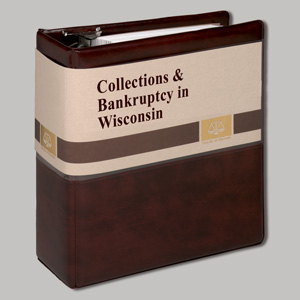
June 4, 2025 – Growing economic uncertainty has created an increased demand for bankruptcy attorneys, making opportunities for lawyers who want to learn the law and financials that govern a specialized federal practice.
Bankruptcy attorneys advise lawyers interested in entering the practice area to find a mentor, become active in the State Bar’s Bankruptcy, Insolvency, & Creditors’ Rights Section (BICR), take advantage of learning opportunities, and start with simple cases.
More Cases
Bankruptcy is up 20% to 30% “based on the area of the state you are in and is expected to continue to climb,” said J. David Krekeler in the State Bar CLE “Build Your Practice: The Nuts and Bolts of Collections and Creditors’ Rights 2025,” available on demand.
 Jay D. Jerde, Mitchell Hamline 2006, is a legal writer for the State Bar of Wisconsin, Madison. He can be reached by email or by phone at (608) 250-6126.
Jay D. Jerde, Mitchell Hamline 2006, is a legal writer for the State Bar of Wisconsin, Madison. He can be reached by email or by phone at (608) 250-6126.
Krekeler, of Krekeler Law, S.C., in Madison began as a general practitioner but has practiced debtor-side bankruptcy law since the 1980s.
Bankruptcies declined 48 straight quarters from 2012 to 2023, Krekeler said. The reduced cases encouraged lawyers to find other areas of practice, and during that time, lawyers also retired.
Sherry Coley at Amundsen Davis LLC in Green Bay, who represents creditors, began noticing an increase in debt workouts and cases in the last quarter of 2024. Higher interest rates make it harder to refinance, and challenging economic forces may be ahead.
Debtor-side attorney Virginia E. George of Swanson Sweet LLP in Milwaukee has noticed similar anecdotal evidence. “We definitely are hearing from more business owners that they have identified they have a serious financial problem.”
Chapter 7 bankruptcy liquidations appear to have gotten busier, and the calendars George received in her role as a bankruptcy trustee are more heavily scheduled, she said.
Be Prepared
An inexperienced bankruptcy attorney can destroy a debtor’s case through mistakes that require dismissal, prevent debt discharge, or worse, coax the client into violating federal law by misstatements on filings, George warns.

“One of the great things about being in this field is that the bankruptcy bar is a really excellent group of people,” said debtor-side attorney Virginia E. George of Swanson Sweet LLP in Milwaukee. “They are so willing to share information with each other, tips and tricks and guide each other through our practice.”
It’s a different environment. Bankruptcy courts are federal courts operating under the Federal Rules of Bankruptcy Procedure. These specialized courts have technical expertise – and have broad powers.
For example, the court may review attorney fees for reasonableness, George said.
Above the court, a government agency, the Office of the United States Trustee in the Department of Justice, monitors every case.
“You have to be ready to respond to those questions and have anticipated what they are going to ask for because you can’t start looking at the facts after you’ve jumped the horse over the hurdle. You have to anticipate what’s going to be on the other side of the hurdle,” George said.
It takes more than a single day-long CLE to become proficient, George said.
Fortunately, many resources are available to prepare. Foremost is BICR, a section that costs $40 a year and is easy to join from the State Bar website.
BICR members receive “access to one of the best resources available for new and veteran bankruptcy attorneys alike – the BICR e-list,” a “ready-made mentoring system,” said Ben Payne, a bankruptcy attorney at Hanson & Payne LLC of Milwaukee with 23 years of experience and chairperson-elect of BICR.
“BICR’s e-list contains hundreds of questions and answers on bankruptcy/creditor’s rights issues, many of the questions having multiple answers providing different perspectives and strategies regarding the same issue,” Payne said.
In addition to State Bar CLEs including annual bankruptcy and creditor’s rights updates in Madison and Milwaukee each November, BICR has an annual retreat including a day and a half program with CLEs, Coley recommended.
Other educational opportunities exist from the federal district court bankruptcy bars.
The American Bankruptcy Institute (ABI) also “has a robust educational track” and access to legal research, George recommended.
Another type of resource, George said, is the Turnaround Management Association, which is a professional group of attorneys, financial advisors, appraisers, auctioneers, and banks that seeks to “improve the quality of turnaround and restructuring” – tools to help debtors.
The best way to learn is the personal connection, whether by e-list or mentoring. George advises law firm experience – she began as outside counsel for First Wisconsin Bank (now a part of U.S. Bank) and started representing debtors in 2005 – although fewer firms have bankruptcy as a practice area.
“One of the great things about being in this field is that the bankruptcy bar is a really excellent group of people,” George said. “They are so willing to share information with each other, tips and tricks and guide each other through our practice.”
“It’s a small bankruptcy bar in this state, and we’re close,” Coley said.
CLE: The Nuts and Bolts of Collections and Creditors’ Rights 2025

Whether due to a mortgage, credit cards, or medical bills, the average American carries over $100,000 in debt. With high interest rates and record debt levels in the U.S., business and individual bankruptcy filings are on the rise. So where does that leave creditors?
The Nuts and Bolts of Collections and Creditors’ Rights, available on demand, offers a foundation in creditor and debtor law so you can advise clients on the best courses of action to recoup what’s owed. Learn the fundamentals of the collections process, including:
Assessing debt and making a demand
Commencing a legal action
Securing favorable judgments
Maximizing collection outcomes
Find out more at WisBar Marketplace.
More Than Bankruptcy Law
Bankruptcy practice covers more than bankruptcy law. One needs to know the laws affecting creditors and debtors, plus the ability to obtain and read financial records.

“You have to have some marginal working comfort level with financial statements,” said Sherry Coley of Amundsen Davis LLC in Green Bay.
Among the areas of law one needs to understand, George listed the Uniform Commercial Code, creditor-debtor, landlord-tenant, real estate, and the Employee Retirement Income Security Act (ERISA), which governs employer-sponsored retirement plans.
“You really need to have a well-versed background in all these other types of civil law so that you understand what the rights of the parties are because the rights don’t necessarily change completely in a bankruptcy,” George said.
A bankruptcy lawyer also needs financial literacy. “You have to have some marginal working comfort level with financial statements,” Coley said. “What are they? How do you read them?”
“The bankruptcy law is fact driven, so you have to understand the facts of all of your clients’ financial transactions,” George explained. This includes bank statements, credit card statements, and financial records – and knowing “whether the records are accurate and authentic.”
Krekeler, whose typical clients include farmers and small businesses, finds it fascinating to learn about his clients' businesses.
One needs to be practical in helping struggling debtors, bankruptcy attorneys advise. “The goal is not to file,” George said. Better solutions involve working with creditors.
“It doesn’t do any good if you save the business, but the business doesn’t have enough money to function,” George said. Keeping a business running with enough resources to pull through also preserves value for creditors – and saves jobs.
Different Practices
“There’s more than one way to do this,” Krekeler said about bankruptcy practice. He prides himself on providing more for his clients. Other firms may focus on simpler types of bankruptcies or work in volume.

“There’s more than one way to do this,” said J. David Krekeler said about bankruptcy practice.
“Bankruptcy is one of the few practice areas in which a recent law school grad can still rent a space, hang up their shingle, and run their own legal practice,” Payne advised.
“The bankruptcy practice in Wisconsin primarily consists of small firms, nearly all of which started with one or a small handful of people and found a way to pay the bills and still make some money without having to sacrifice a certain amount of self-determination by joining large firms,” Payne said.
Payne suggests this plan is within reach. “With most bankruptcy client meetings these days taking place via Zoom or Teams, a fancy leased office space with a big conference room has become an expense most somewhat tech-savvy practitioners can avoid altogether.”
George advises starting with simple cases. “If you’re going to dip your toe into the bankruptcy bar, I would say start at the shallow end and limit yourself to cases where it is only a wage earner, they do not own a business, and their debt is traditional debt.”
“Bankruptcy is a great field of law to go into if you’re changing fields or adding a field,” George said. No two cases are the same, no two clients are the same, “and being interested in their financial outcomes and really believing in the whole concept of a fresh start.”
One of the great rewards George feels is “we have saved a lot of jobs,” in Wisconsin and the Midwest, “good paying jobs that can support a family, and when you do that, it feels good.”
Collections & Bankruptcy in Wisconsin

Review the legal ramifications of financial problems that could strike any business or individual client. Whether you’re looking for information on collection remedies, negotiating agreements with creditors, or resolving a bankruptcy proceeding, Collections & Bankruptcy in Wisconsin is the perfect starting point.
As one of the few Wisconsin-specific publications to provide a detailed overview of both collections and bankruptcy in a single volume, Collections & Bankruptcy in Wisconsin is broadly applicable to your needs. By combining Wisconsin-specific analysis with federal elements, this book is filled with the “who, what, when, where, and why” that lets you discover “how” to best represent your clients.
Collections & Bankruptcy arms you with a basic overview of the complex legal issues involved in business financial problems, allowing you to:
Review the law behind judgments, general consumer collection considerations, and supplemental proceedings. This chapter also covers garnishments, replevin actions, and marital property considerations.
Consider various approaches to potential resolution of financial problems faced by businesses or individuals.
Whether you represent creditors or debtors, you’ll find practical advice on how to protect your clients’ interests in Collections & Bankruptcy in Wisconsin.
Find out more at WisBar Marketplace.
